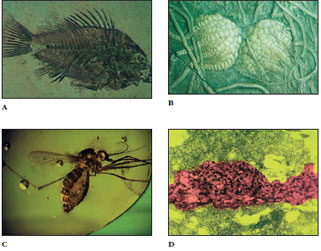Perpetual Change
Darwinian
Evolutionary
Theory: The
Evidence
Perpetual Change
The main premise underlying Darwinian
evolution is that the living world
is neither constant nor perpetually
cycling, but always changing. Perpetual
change in the form and diversity of animal
life throughout its 600- to 700-
million-year history is seen most directly
in the fossil record. A fossil is a remnant
of past life uncovered from the
crust of the earth (Figure 6-8). Some
fossils constitute complete remains
(insects in amber and mammoths),
actual hard parts (teeth and bones),
and petrified skeletal parts that are infiltrated
with silica or other minerals
(ostracoderms and molluscs). Other
fossils include molds, casts, impressions,
and fossil excrement (coprolites).
In addition to documenting organismal
evolution, fossils reveal profound
changes in the earth’s environment,
including major changes in the distributions
of lands and seas. Because many
organisms left no fossils, a complete
record of the past is always beyond our
reach; nonetheless, discovery of new
fossils and reinterpretation of existing
ones expand our knowledge of how
the form and diversity of animals
changed through geological time.
Fossil remains may on rare occasions include soft tissues preserved so well that recognizable cellular organelles can be viewed by electron microscopy! Insects are frequently found entombed in amber, the fossilized resin of trees. One study of a fly entombed in 40-million-year-old amber revealed structures corresponding to muscle fibers, nuclei, ribosomes, lipid droplets, endoplasmic reticulum, and mitochondria (Figure 6-8D).This extreme case of mummification probably occurred because chemicals in the plant sap diffused into the embalmed insect’s tissues
Perpetual Change
 |
| Figure 6-8 Four examples of fossil material. A, Fish fossil from rocks of the Green River Formation, Wyoming. Such fish swam here during the Eocene epoch of the Tertiary period, approximately 55 million years ago. B, Stalked crinoids (class Crinoidea) from 85-million-year-old Cretaceous rocks. The fossil record of these echinoderms shows that they reached their peak millions of years earlier and began a slow decline to the present. C, An insect fossil that got stuck in the resin of a tree 40 million years ago and that has since hardened into amber. D, Electron micrograph of tissue from a fly fossilized as shown in C; the nucleus of a cell is marked in red. |
Fossil remains may on rare occasions include soft tissues preserved so well that recognizable cellular organelles can be viewed by electron microscopy! Insects are frequently found entombed in amber, the fossilized resin of trees. One study of a fly entombed in 40-million-year-old amber revealed structures corresponding to muscle fibers, nuclei, ribosomes, lipid droplets, endoplasmic reticulum, and mitochondria (Figure 6-8D).This extreme case of mummification probably occurred because chemicals in the plant sap diffused into the embalmed insect’s tissues




